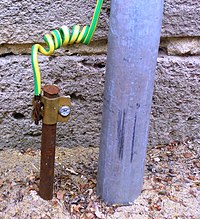
Photo from wikipedia
Abstract Collecting aerosol particles is important in public health viewpoint because aerosol particles have been resulting in million deaths every year. Electrostatic precipitators (ESPs) are widely used to deal with… Click to show full abstract
Abstract Collecting aerosol particles is important in public health viewpoint because aerosol particles have been resulting in million deaths every year. Electrostatic precipitators (ESPs) are widely used to deal with massive particles at a given airflow rate because of several advantages attributed to ESPs' low pressure drop. However, the collection efficiency of an ESP decays quickly when demanding a higher airflow rate. This paper presents the characteristics of a two-stage ESP that has a square-wave collecting electrode proposed to handle massive particles while preventing the collection efficiency from decreasing too fast when the airflow rate increases. The results show that, when almost doubling the airflow rate, the decreasing of the collection efficiency of an ESP using the square-wave collecting electrode is 8.4%, while that using the conventional flat-plate collecting electrode is 17.5%. The visual examinations of the particle depositions suggest that large particles likely impact the upstream walls of the square-wave structure, whereas small particles tend to recirculate and deposit on the downstream walls of the square-wave structure. Moreover, because of the increasing resistivity, it was observed that the massive particles accumulating in the charger causes the corona voltage increase when the corona current keeps at a constant.
Journal Title: Powder Technology
Year Published: 2020
Link to full text (if available)
Share on Social Media: Sign Up to like & get
recommendations!